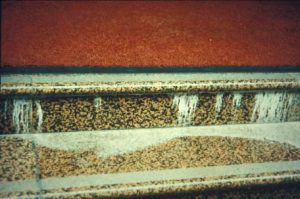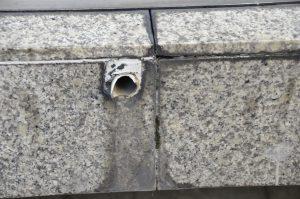Case 1
- Introduction
- Causes of Defects
- Good Practices
- Standards
- Maintenance and Diagnostics
- Remedial
- Similar Cases
- References

Introduction
Leaching of Soluble Salts
Type of Building: Commercial Building
Type of Façade: Tiled Façade
Leaching of soluble salts are common with mortar joints when they are not properly constructed. This will lead to staining over the tiles when they crystallise.
White streaks of deposit were spotted some distance below the hairline cracks along the external wall. These were especially prominent along light coloured walls. This defect is one of concern as it reduce the aesthetic appearance of the building.
Efflorescence is a harmless defect that is considered to be only a temporary disfigurement on new buildings that is removed by weathering agents within a year or so of construction. Even where it does return in cycles following wetter weather, unless there is a supply of salts from another source, the deposits will gradually reduce in intensity until it disappears altogether.
In new work, the extent is often related to the amount of rainwater that enters the structure during the construction process. Post construction efflorescence will always occur where percolating water affects the materials. Salts will be taken into solution and deposited on the edge of the damp-affected area.
Cracks on tiled façade exposes the substrate to water penetration. This might lead to efflorescence formation when the lime product in the backing wall is leached out by the rainwater. The water seepage may also bring about dampness in the interior of the building, resulting in damage to wallpaper (Figure 1).
- Efflorescence is a harmless defect that is considered to be only a temporary disfigurement on new buildings
- Can be removed by weathering agents within a year or so of construction.
- Even when it does return in cycles following wetter weather, unless there is a supply of salt from another source, the deposits will gradually reduce in intensity until it disappears altogether.
- In new work, the extent of efflorescence is often related to the amount of rainwater that enters the structure during the construction process. Post construction efflorescence will always occur where percolating water affects the materials. Salts will be taken into solution and deposited on the edge of the damp-affected area.
- Persistent efflorescence should be taken as a warning that water is entering the wall and this may cause deterioration of wall materials and have other consequences.


